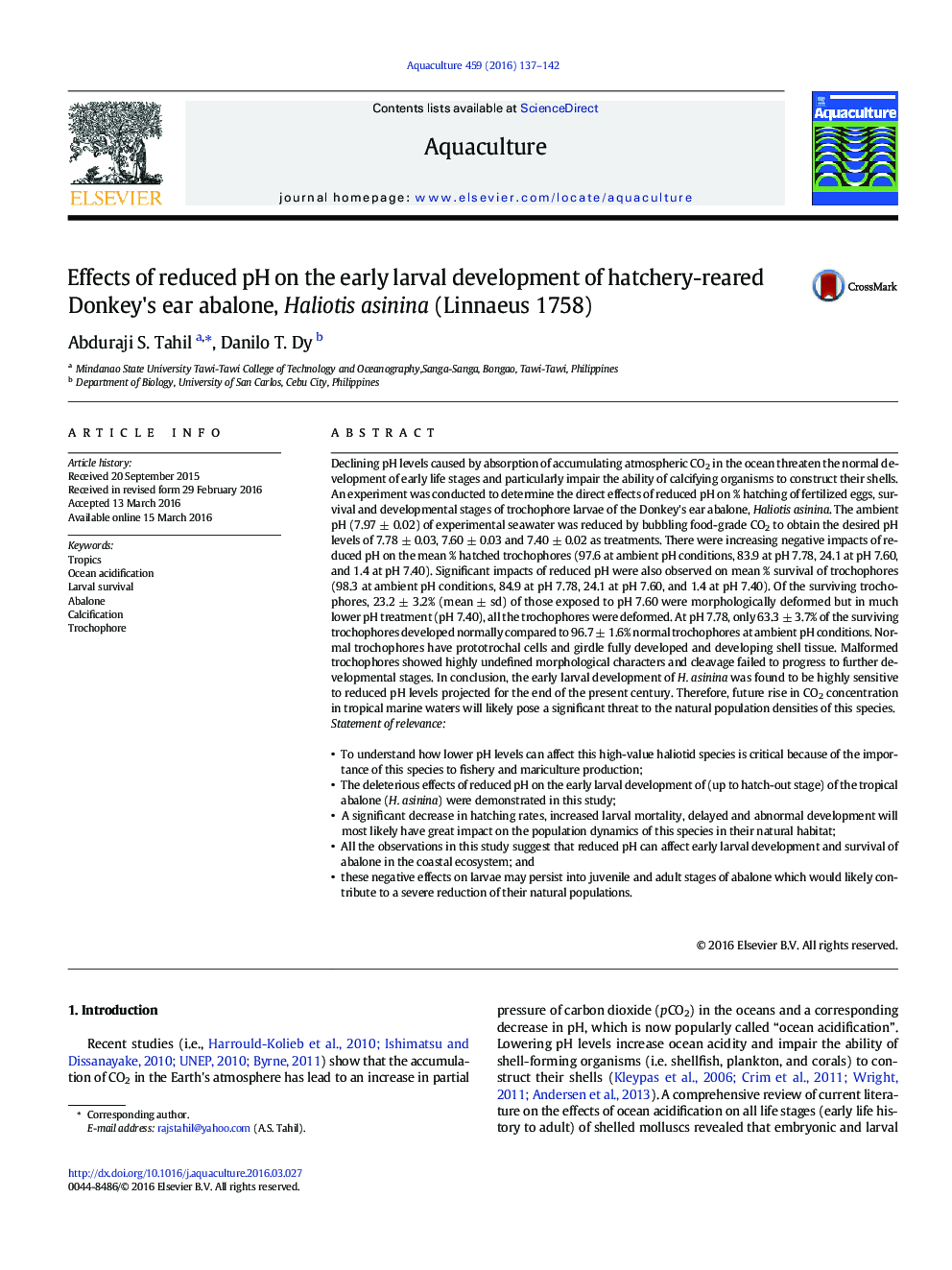| کد مقاله | کد نشریه | سال انتشار | مقاله انگلیسی | نسخه تمام متن |
|---|---|---|---|---|
| 2421429 | 1552828 | 2016 | 6 صفحه PDF | دانلود رایگان |

• Recent studies of other workers on the effects of reduced pH on the early development of abalone are included in the revised manuscript, particularly in the Introduction and Discussion sections of the manuscript.
• Experimental design and statistical analysis and materials and methods
• Response variables (% hatching rate, % normal hatched trochophores, and % survival) - consistency between those presented in the Materials and Methods section and those in the Results section of the revised manuscript
• Presentation and/or restructuring of results
• Inclusion of research highlights
• References
Declining pH levels caused by absorption of accumulating atmospheric CO2 in the ocean threaten the normal development of early life stages and particularly impair the ability of calcifying organisms to construct their shells. An experiment was conducted to determine the direct effects of reduced pH on % hatching of fertilized eggs, survival and developmental stages of trochophore larvae of the Donkey's ear abalone, Haliotis asinina. The ambient pH (7.97 ± 0.02) of experimental seawater was reduced by bubbling food-grade CO2 to obtain the desired pH levels of 7.78 ± 0.03, 7.60 ± 0.03 and 7.40 ± 0.02 as treatments. There were increasing negative impacts of reduced pH on the mean % hatched trochophores (97.6 at ambient pH conditions, 83.9 at pH 7.78, 24.1 at pH 7.60, and 1.4 at pH 7.40). Significant impacts of reduced pH were also observed on mean % survival of trochophores (98.3 at ambient pH conditions, 84.9 at pH 7.78, 24.1 at pH 7.60, and 1.4 at pH 7.40). Of the surviving trochophores, 23.2 ± 3.2% (mean ± sd) of those exposed to pH 7.60 were morphologically deformed but in much lower pH treatment (pH 7.40), all the trochophores were deformed. At pH 7.78, only 63.3 ± 3.7% of the surviving trochophores developed normally compared to 96.7 ± 1.6% normal trochophores at ambient pH conditions. Normal trochophores have prototrochal cells and girdle fully developed and developing shell tissue. Malformed trochophores showed highly undefined morphological characters and cleavage failed to progress to further developmental stages. In conclusion, the early larval development of H. asinina was found to be highly sensitive to reduced pH levels projected for the end of the present century. Therefore, future rise in CO2 concentration in tropical marine waters will likely pose a significant threat to the natural population densities of this species.Statement of relevance
• To understand how lower pH levels can affect this high-value haliotid species is critical because of the importance of this species to fishery and mariculture production;
• The deleterious effects of reduced pH on the early larval development of (up to hatch-out stage) of the tropical abalone (H. asinina) were demonstrated in this study;
• A significant decrease in hatching rates, increased larval mortality, delayed and abnormal development will most likely have great impact on the population dynamics of this species in their natural habitat;
• All the observations in this study suggest that reduced pH can affect early larval development and survival of abalone in the coastal ecosystem; and
• these negative effects on larvae may persist into juvenile and adult stages of abalone which would likely contribute to a severe reduction of their natural populations.
Journal: Aquaculture - Volume 459, 1 June 2016, Pages 137–142